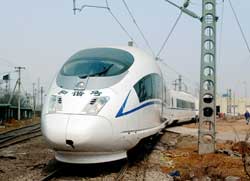A New Chinese Record

The train left the station in Beijing at 8:55 a.m. on June 24 to smash the old record about 20 minutes later. This momentous event was witnessed by the Minister of Railways, Liu Zhijun. Based on the Velaro CN designed by Siemens and built in Tangshan, China, the train finally set a new record speed of 394.3 km/h on the return trip from Tianjin to Beijing.
Ernst Reuss, project manager for the Velaro CN at Siemens, was also there for the record-breaking event: “We were traveling practically at sea level, as Tjanjin is a port city. This meant the drag coefficient was higher. Besides that, the train is heavier and wider than the Velaro in Spain. All in all, this new speed record is quite a respectable achievement!”
Five CRH 3 trains are to start running between the two Olympic sports venues from August 1 onwards. China Rail ordered a total of 60 Velaro trains. Three of them have been built in Krefeld in Germany, while the other 57 units are being built at Tangshan Locomotive & Rolling Stock Works in Tangshan.
Angelika Holtkamp
Siemens AG
Industry Sector
TS GC EC
Werner-von-Siemens-Str. 67
91052 Erlangen
Tel.: +49 (9131) 7-24880
Fax: +49 (9131) 7-24598
Mobil: +49 (172) 1325400
mailto:angelika.holtkamp@siemens.com
Media Contact
More Information:
http://www.siemens.comAll latest news from the category: Transportation and Logistics
This field deals with all spatial and time-related activities involved in bridging the gap between goods and people, including their restructuring. This begins with the supplier and follows each stage of the operational value chain to product delivery and concludes with product disposal and recycling.
innovations-report provides informative reports and articles on such topics as traffic telematics, toll collection, traffic management systems, route planning, high-speed rail (Transrapid), traffic infrastructures, air safety, transport technologies, transport logistics, production logistics and mobility.
Newest articles

Why getting in touch with our ‘gerbil brain’ could help machines listen better
Macquarie University researchers have debunked a 75-year-old theory about how humans determine where sounds are coming from, and it could unlock the secret to creating a next generation of more…

Attosecond core-level spectroscopy reveals real-time molecular dynamics
Chemical reactions are complex mechanisms. Many different dynamical processes are involved, affecting both the electrons and the nucleus of the present atoms. Very often the strongly coupled electron and nuclear…

Free-forming organelles help plants adapt to climate change
Scientists uncover how plants “see” shades of light, temperature. Plants’ ability to sense light and temperature, and their ability to adapt to climate change, hinges on free-forming structures in their…





















